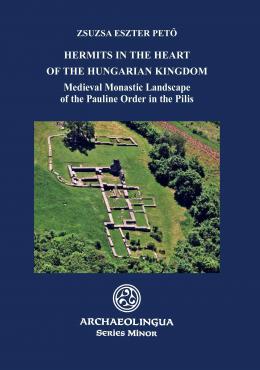Hermits in the Heart of the Hungarian Kingdom

Hermits in the Heart of the Hungarian Kingdom
| 7 672 Ft |
| Price |
Series Minor No. 41
Budapest, Archaeolingua, 2018
Puhakötés | Paper book
187 oldal, színes és fekete-fehér illusztrációkkal | 187 pages with colored and grayscale images
ISBN 978-615-5766-09-1
Table of contents // Tartalomjegyzék
Description
“…first, the order was settled only in deserted, uninhabited, forested places, far from populated areas and lived a monkish life in small cells and chapels, which can still be found in some places; but as time went by, the cells have been transformed into great monasteries through donations, the chapels into splendid churches, and several other necessary buildings were erected around the monasteries.”
Thus was the history of the Pauline Order interpreted by Pope Eugene IV in his letter to Dionysios, Archbishop of Esztergom, in 1440. The Pauline Order is the single monastic order of Hungarian origin, and according to their tradition, they first emerged in the Pilis forest. The area of the Pilis, located in the heartland of the Hungarian kingdom, is crucial for Hungarian history, as this royal forest was surrounded by the most important royal centers and residences in the Middle Ages. Since the Pilis is a densely forested area even today, the features of the Pauline monastic space are well preserved and can be described with the methods of landscape archaeology, yielding new results through a systematic analysis and a complex approach on a digital platform, by using GIS technology.
The aim of this study is to answer some key research questions and to summarize the evolution of the Pauline Order at different levels of space in the Pilis: from the basic spatial organization of the smallest monastic estate to their role in the entire area of the main royal forest of the Kingdom of Hungary. Studies on the Order of St. Paul the First Hermit, often supplemented with archaeological and architectural investigations, have always held a prominent place in historical research in Central Europe; however, various other features that accompanied these monasteries (such as the remains of fishponds, dikes, mills and roads) were often neglected. Thus, the present work is a new contribution to the study of medieval monastic landscapes, which offers new insights regarding not only the Pauline Order, but also the different research approaches to the study of medieval monasticism.
| |
|
|
1067 Budapest, Teréz krt. 13. |
|
|
|
|
About us
The Archaeolingua Foundation and Publisher is involved in publishing series and standalone publications in the disciplines of archaeology, linguistics, historic sciences and heritage protection for over 25 years.
Learn more
Publishing
We publish both as standalone editions and as a volume of a professional series.
Learn more
Contact us
Archaeolingua Foundation

